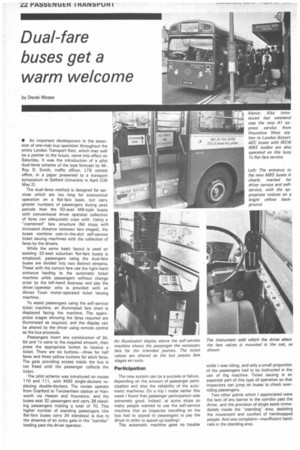Dual-fare buses get a warm welcome
Page 24

If you've noticed an error in this article please click here to report it so we can fix it.
• An important development in the extension of one-roan bus operation throughout the entire London Transport fleet, which may well be a pointer to the future, came into effect on Saturday. It was the introduction of a pilot dual-fares scheme of the type forecast by Mr. Roy D. Smith, traffic officer, LTB central office, in a paper presented to a transport symposium at Salford University in April (CM May 2).
The dual-fares method is designed for services which are too long for economical operation on a flat-fare basis, but carry greater numbers of passengers during peak periods than the 50-seat MB-type buses with conventional driver operator collection of fares can adequately cope with. Using a "coarsened" fare structure (6d steps with increased distance between fare stages), the buses combine coin-in-the-slot self-service ticket issuing machines with the collection of fares by the drivers.
While the same basic layout is used on existing 32-seat suburban flat-fare buses is employed, passengers using the dual-fare buses are divided into two distinct streams. Those with the correct fare use the right-hand entrance leading to the automatic ticket machine while passengers without change enter by the left-hand doorway and pay the driver/operator who is provided with an Almex Town motor-operated ticket issuing machine.
To assist passengers using the self-service ticket machine, an illuminated fare chart is displayed facing the machine. The appropriate stages showing the fares required are illuminated as required, and the display can be altered by the driver using remote control as the bus proceeds.
-Passengers insert any combination of 3d, 6d and 1s coins to the required amount, then press the appropriate button to receive a ticket. There are six buttons—three for half fares and three yellow buttons for adult fares. The gate providing access inside the bus is not freed until the passenger collects the ticket.
The pilot scheme was introduced on routes 110 and 111, with MBS single-deckers replacing double-deckers. The routes operate from Cranford to Twickenham station or Hanworth via Heston and Hounslow, and the buses seat 32 passengers and carry 38 standing passengers making a total of 70. This higher number of standing passengers (the flat-fare buses carry 34 standees) is due to the absence of an entry gate in the "corridor
leading past the driver operator. An illuminated display above the self-service machine shows the passenger the necessary fare for the intended journey. The ticket values are altered as the bus passes fare stages en route.
Participation
The new system can be a success or failure, depending on the amount of passenger participation and also the reliability of the automatic machines. On a trip I made earlier this week I found that passenger participation was extremely good. Indeed, at some stops so many people wanted to use the self-service machine that an inspector travelling on the bus had to appeal to passengers to pay the driver in order to speed-up loading!
The automatic machine gave no trouble The instrument with which the driver alters the fare values is mounted in the cab, as shown.
while I was riding, and only a small proportion of the passengers had to be instructed in the use of thq machine. Ticket issuing Is an essential part of this type of operation so that inspectors can jump on buses to check overriding passengers.
Two other points which I appreciated were the lack of any barrier in the corridor past the driver, and the provision of single seats immediately inside the "standingarea, assisting the movement and comfort of handicapped people. And one complaint—insufficient handrails in the standing area.




































































































